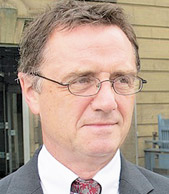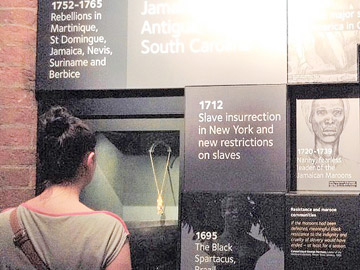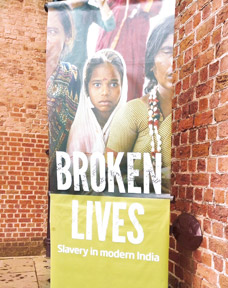Broken lives and social justice
New role for museums as Liverpool chooses focus on
human rights and be upfront about it:
by A.D. Mckenzie
 |
|
Dr David Fleming, director
of National Museums Liverpool, which includes the city’s
International Slavery Museum. Credit: National Museums Liverpool
|
An exhibition on modern-day slavery at the International Slavery
Museum in Liverpool, is just one example of a museum choosing to focus
on human rights, and being 'upfront' about it.
"Social justice just doesn't happen by itself; it's about activism
and people willing to take risks," says Dr David Fleming, director of
National Museums Liverpool, which includes the city's International
Slavery Museum (ISM).
The institution looks at aspects of both historical and contemporary
slavery, while being an 'international hub for resources on human rights
issues'.
It is a member of the Liverpool-based Social Justice Alliance for
Museums (SJAM), formed in 2013 and now comprising more than 80 museums
worldwide, and it coordinated the founding of the Federation of
International Human Rights Museums (FIHRM) in 2010.
The aim of FIHRM is to encourage museums which 'engage with sensitive
and controversial human rights themes' to work together and share 'new
thinking and initiatives in a supportive environment'. Both
organisations reflect the way that museums are changing, said Fleming.
"Museums are not dispassionate agents," he says, adding, "They have a
role in safeguarding memory. We have to look at the role of museums and
see how they can transform lives."
The International Slavery Museum's current exhibition, titled 'Broken
Lives' and running until April 2016, focuses on the victims of global
modern-day slavery - half of whom are said to be in India, and most of
whom are Dalits, or people formerly known as 'untouchables'.
The display "provides a window into the experiences of Dalits and
others who are being exploited and abused through modern slavery in
India", say the curators.
"Dalits still experience marginalisation and prejudice, live in
extreme poverty and are vulnerable to human trafficking and bonded
labour," they add.
 |
|
A visitor looking at a
panel at the International Slavery Museum in Liverpool, England.
Credit: A.D. McKenzie/IPS |
Presented in partnership with the Dalit Freedom Network, the
exhibition uses photographs, film, personal testimony and other means to
show 'stories of hardship' that include sexual servitude and child
bondage. It also profiles the activists working to mend 'broken lives'.
"Museums (in Liverpool, Nantes, Guadeloupe and Bordeaux ) hope that
they can play a role in global citizenship, educating the public and
encouraging visitors to leave with a different mind-set - about respect
for human rights, social justice, diversity, equality, and
sustainability"
Legacy of racism
The display occupies a temporary exposition space at the museum,
which has a permanent section devoted to the atrocities of the
trans-Atlantic slave trade and the legacy of racism.
Along with the Memorial to the Abolition of Slavery in the French
city of Nantes and the recently opened Mémorial ACTe in Guadeloupe, the
Liverpool museum is one of too few national institutions focused on
raising awareness about slavery, observers say.
But it has provided a 'vital source of inspiration' to permanent
exhibitions on the slave trade in places such as Bordeaux, southwest
France, according to the city's Mayor Alain Juppé. Here, the Musée
d'Aquitaine hosts a comprehensive division called 'Bordeaux,
Trans-Atlantic Trading and Slavery' - with detailed, unequivocal
information.
These museums hope they can play a role in global citizenship,
educating the public and encouraging visitors to leave with a different
mind-set - about respect for human rights, social justice, diversity,
equality, and sustainability.
"We try to overtly encourage the public to get involved in the fight
for human rights," Fleming says, adding, "We've often said at the
Slavery Museum that we want people to go away fired up with the desire
to fight racism. "You can't dictate to people what they're going to
think or how they're going to respond and react," he continues,
claiming,"But you can create an atmosphere, and the atmosphere at the
Slavery Museum is clearly anti-racist. We hope people will leave
thinking: I didn't know all those terrible things had happened and I'm
leaving converted."
Despite Liverpool's undeniable history as a major slaving port in the
18th century, not everyone will be affected in the same way, however.
There have been swastikas painted on the walls of the museum in the
past, as bigots reject the institution's aims.
Mobilising Memory
 |
|
A poster sign for the
‘Broken Lives’ exhibition under way at the International Slavery
Museum in Liverpool. Credit: A.D. McKenzie/IPS |
"Some people come full of knowledge and full of attitude already, and
I don't imagine that we affect these people. But we're looking for
people in the middle, who might not have thought about this," says
Fleming.
He describes a visit to the museum by a group of English
schoolchildren who initially did not comprehend photographs depicting
African youngsters whose hands had been cut off by colonialists.
When they were given explanations about the images, the
schoolchildren "switched on to the idea that people can behave
abominably, based on nothing but ethnicity," he explains.
Fleming visits social justice exhibitions around the world and gives
information about the museum's work. As a keynote speaker, he recently
delivered an address about the role of museums at a conference in
Liverpool titled 'Mobilising Memory: Creating African Atlantic
Identities'.
The meeting - organised by the Collegium for African American
Research (CAAR) and a new UK-based body called the Institute for Black
Atlantic Research - took place at Liverpool Hope University at the end
of June.
It began a few days after a white gunman killed nine people inside
the historic Emanuel African Methodist Episcopal Church, in the US state
of North Carolina.
The murders, among numerous incidents of brutality against African
Americans over the past year, sparked a sense of urgency at the
conference as well as heightened the discussion about activism - and
especially the part that writers, artists and scholars play in
preserving and "activating" memory in the struggle for social justice
and human rights.
"Artists, and by extension museums, have what some people have called
a 'burden of representation', and they have to deal with that," says
James Smalls, a professor of art history and museum studies at the
University of Maryland, Baltimore County (UMBC).
"Many times, artists automatically are expected to speak on behalf of
their ethnic group or community, and some have chosen to embrace that
while others try to be exempt," he adds.
Scholarship and activism
Claire Garcia, a professor at Colorado College, says that for a
number of academics "there is no necessary link between scholarship and
activism" in what are considered scholarly fields.
Such thinkers make the point that scholarship should be 'theoretical'
and 'universal', and not political or focused on 'the specific plights
of one group'," she said. However, this standpoint - "when it is
disconnected from the embattled humanity" of some ethnic groups - can
create further problems.
The concept of museums standing for 'social justice' is controversial
as well because the issue is seen differently in various parts of the
world. The line between 'objectifying and educating"' also gives cause
for debate.
Fleming says the National Museums Liverpool, for example, would not
have put on the contentious show 'Exhibit B' - which featured live Black
performers in a "'human zoo' installation; the work was apparently aimed
at condemning racism and slavery but instead drew protests in London,
Paris and other cities in 2014.
"Personally I loathe all that stuff, so my vote would be 'no' to
anything similar," Fleming says and adds,"And that's not because it's
controversial and difficult but because it's degrading and humiliating.
There are all sorts of issues with it, and I've thought about that quite
a lot."
He and other scholars say that they are deeply conscious of who is
doing the 'story-telling' of history, and this is an issue that also
affects museums.
Moral compass
Several participants at the CAAR conference criticised certain
displays at the International Slavery Museum, wondering about the
intended audience, and who had selected the exhibits, for instance.
A section that showed famous individuals of African descent seemed
superficial in its glossy presentation of people such as American
talk-show host Oprah Winfrey and well-known athletes and entertainers.
Fleming says museums often face disapproval for both going too far
and not going "far enough". But taking a disinterested stand does not
seem to be the answer, because "the world is full of 'faux-neutral'
museums", he says.
The most relevant and interesting museums can be those that have a
'moral compass', but they need help as they can "do very little by
themselves," Fleming says. The institutions that he directs often work
with non-governmental organisations that bring their own expertise and
point of view to the exhibitions, he explained. Apart from slavery,
individual museums around the world have focused on the Holocaust, on
apartheid, on genocide in countries such as Cambodia, and on the
atrocities committed during dictatorships in regions such as Latin
America.
"Some countries don't want museums to change," said Fleming. "But in
Liverpool, we're not just there for tourism."
-IPS |

